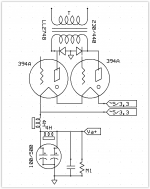There are two 4H windings (connections 6+4, and 1+3). In series they are 8H. in parallel they are 2H.
The two windings are 2H each alone or in parallel since the number of turns does not change. Adding them in series doubles the turns which nets 4X the inductance.
dave
i'm not sure about the channel separation as the right and left channel capacitor are separate by 200 ohm in my case . ( 20H in each coil). but i fully agree that it is not the optimal way to make a dual choke works
anyway please don't fight for this .. 🙂
anyway please don't fight for this .. 🙂
The two windings are 2H each alone or in parallel since the number of turns does not change. Adding them in series doubles the turns which nets 4X the inductance.
dave
Hi Dave, of course you're right. Thanks for being patient. I had figured all this out months ago of course and when I go back to my original calculations it makes sense...
However, over the audible audio spectrum, using sound generator and osilloscope the channel separation I achieve is just as good as with two separate chokes. I'm not getting any bleed over. No distortions that I can measure.
This amp has been running since many months now and is dead silent with only 2H filter choke on each channel. Of course I am using noise cancellation... 😉
Ian
Last edited:
Sorry, Thomas has this exactly right and you need to take another look at how mutually coupled windings work. It is a transformer for anything that gets past the last capacitors in the filter network.. i.e, LF stuff, and you are throwing away 75% of available inductance that would otherwise be available. It's a compromise ultimately in low frequency isolation between channels and in potential rippled reduction - worst really of both worlds. One of those issues can be mitigated by doing what he suggests (both windings in series).
I have run two separate chokes in parallel and all my measurements have shown no difference. Sounds the same too. I tested channel to channel down to about 12Hz and all was fine. No such problems with low frequency isolation as you suggest.
Ok, so I throw away 75% inductance. But 2H is really enough for my application. Doing it with a single piece of iron is nice too. I admit that I only use it in this one application though.
Last edited:
i'm not sure about the channel separation as the right and left channel capacitor are separate by 200 ohm in my case . ( 20H in each coil). but i fully agree that it is not the optimal way to make a dual choke works
anyway please don't fight for this .. 🙂
I would would use a choke like that in a phono-amplifier or pre-amplifier and definitely use it in series. Then separate the channels with a RC network. Or use two separate chokes in LC network - one choke for each channel.
I would not use it for what I am doing in a Lofting-White end-stage with noise cancellation in a phono or pre-amplifier. Maybe the noise cancellation that I employ actually is what makes it work for my application.
Something to think about...
Ian
Last edited:
Hi Ian,
If you don't get a noticeable difference when using separate chokes, that doesn't make the use of the two halves right as you did. It just means that it doesn't make a difference in your application. I am quite sure if you simply use a single choke and cap it will also be the same. If you want less resistance you can use a LL1638 with both coils wired in parallel to get 9 Ohms, even better than what you have now. You might get a little bit of separation in your circuit because the coupling between iota two coils might not be perfect. But for sure these chokes are not designed or intended to be used in this way
Thomas
If you don't get a noticeable difference when using separate chokes, that doesn't make the use of the two halves right as you did. It just means that it doesn't make a difference in your application. I am quite sure if you simply use a single choke and cap it will also be the same. If you want less resistance you can use a LL1638 with both coils wired in parallel to get 9 Ohms, even better than what you have now. You might get a little bit of separation in your circuit because the coupling between iota two coils might not be perfect. But for sure these chokes are not designed or intended to be used in this way
Thomas
This would be one of the special Polisois designs, where DC should compensate magnetic flux but signal would be transformer coupled. I am not a believer.
Is Lundahl the only source out there for dual-coil power supply filter chokes? Does anyone know if Hammond, Edcor, etc. make similar chokes? For the attached application:

- Home
- Amplifiers
- Tubes / Valves
- dual coil choke


